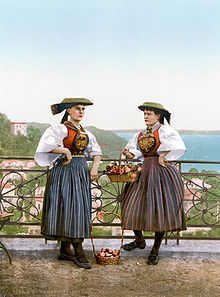Vierländer costume
The Vierlanden costume is a traditional historical clothing that is worn in the Vierlanden .
history
The clothing developed between 1750 and 1770 and was considered a seal of quality for the vegetables from the Vierlanden offered on the Hamburg market . The costume did not differ significantly from the peasant work clothes customary at the time and was worn from Easter to Michaelmas. In 1915, 100 women and three men still dressed in traditional costumes; later it was no longer an everyday item of clothing. Since 1950 the Vierländer Trachtengruppe , since 1964 Vierländer Speeldeel "De Veerlanner" eV has been committed to the maintenance of customs and the memory of the Vierländer Trachten . Today the traditional costumes, which are often more than 100 years old, are only worn at traditional costume and folk festivals.
A large collection of historical four-country costumes is in the Museum of Art and Industry Hamburg.
description
Historically, women's and men's costumes are known for the four-country costume. Preserved copies have extensive, expressive jewelry made of silver. In addition, there were different forms that were worn on special occasions such as visiting the church or at funerals and weddings. Children had their own costumes.
Women's costume
The women's costume consists of one or, depending on the season or taste, several petticoats, a wide overskirt and an apron. The apron and skirt are designed with numerous folds in the waistband. In addition, a white shirt is worn, which is closed with a brooch decorated with semi-precious stones or colored glass stones. Over this women wear a waisted waistcoat, held together by a clasp. The costume is complemented by a tight-fitting jacket with a pointed oval neckline, the sleeves of which are richly decorated with silver buttons. Embroidery typical of the landscape can be found on the lower sleeves of the jacket and on the apron. The neckline of the jacket offers space for an elaborate breast ornament and a bib, which is decorated with metal embroidery. The breast ornament is designed as filigree work and rests on a differently colored, usually gold-plated metal plate.
Women wear a specially designed hood and a straw hat. The black hood is snug and has a noticeable stiff, black bow at the neck. The straw hat worn over it is lower in the area of the head than the roof-like arched brim .
Male costume
The men's costumes consist of short brown jackets with vests underneath and black bloomers . All clothes are provided with many silver buttons. These can be found on the button placket and sleeves of the jacket, on the front of the vest and in a larger version on the trousers. The pants are made of black cloth or English leather. Cord materials were later used for this .
The costume is complemented by a hat. This initially had a wide rim and resembled carpenter's hats. From around 1830, men wore a top hat , which initially had a mostly rough surface, later a smooth surface.
literature
- Franklin Kopitzsch , Daniel Tilgner (Ed.): Hamburg Lexikon. 4th, updated and expanded special edition. Ellert & Richter, Hamburg 2010, ISBN 978-3-8319-0373-3 , p. 728.
- Gerd Hoffmann: The traditional costume of the Vierländer - and the Marschländer farmers. In: Bergedorf-Blätter 06/2003, Ed .: Bergedorfer Bürgererverein (pdf)
- Hermann Haase: Tracht, Haus und Hof der Vierländer: Contributions to cultural history . Janssen, Hamburg, 1910.
Individual evidence
- ↑ Four countries costumes. In: MKG Collection Online. Museum of Arts and Crafts Hamburg, accessed on April 7, 2020 .

